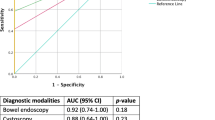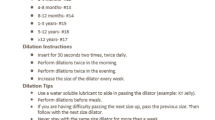Abstract
Purpose
Ostomy is an important step in the treatment of patients with anorectal malformation (ARM). Sometimes this basic surgical procedure may cause a devastating complication.
Methods
The medical reports of the patients with ARM who had ostomy in the past were inspected. How many of them were operated in this center or sent from others, the type of ARM, what type of ostomy performed and which place of the bowel used and the complication type and rate related to ostomy and ostomy closure were evaluated.
Results
Nearly, 157 of 230 patients with ARM had ostomy during twenty-two years were evaluated. The prevelent type of ostomy was loop (50.3%) and then separated (36.9%), end (7%), double barrel (4.4%) and window (1.2%). The ostomies were located in the tranverse colon (53.5%), descending colon (24.2%), sigmoid colon (17.8), pouch colon (2.5%) and ileum (1.9). Total complication rate was found to be 15.2% (24/157) (window 100%, double barrel 42.8%, separated 15.5%, loop 11.3%, end 9%). The main complication of loop ostomies was prolapse whereas wound problems, stenosis, intestinal obstruction or perforation were serious problems of separated ostomies. Complication rate in the descending colon and tranverse colon was found to be 7.1 and 28%, respectively (p = 0.001). Any difference for complication rate between loop and separated ostomies was not found. Eighteen of separated ostomies had mucous fistula and six of them (33%) were complicated, this rate was higher than those without mucous fistula (p = 0.012). Two babies with separated ostomy were lost due to surgical complications (1.2%). Complication rate after ostomy closure was 10.7% [wound infection (4.4%), intestinal obstruction (1.7%)].
Conclusion
According to this study, ostomy performed in the descending colon carries greater risks for complication regardless of its type. Nevertheless, separated ostomy with mucous fistula should be performed by experienced hands.

Similar content being viewed by others
References
Patwardhan N, Kiely EM, Drake DP, Spitz L, Pierro A (2001) Coostomy for anorectal anomalies: high incidence of complications. J Pediatr Surg 36:795–798
Chowdhary SK, Chalapathi G, Narasimhan KL, Samujh R, Mahajan JK, Menon P, Rao KLN (2004) An audit of neonatal colostomy for high anorectal malformation: the developing world perspective. Pediatr Surg Int 20:111–113
Lewitt MA, Pena A (2006) Management in the newborn period. In: Holschneider AM, Hutson JM (eds) Anorectal maformations in children. Springer, New York, pp 289–293
Singal AK, Bhatnagar V (2006) Colostomy prolapse and hernia following window colostomy in congenital pouch colon Pediatr Surg Int 22:459–461
Pena A, Migotto-Krieger M, Lewitt MA (2006) Colostomy in anorectal malformations: a procedure with serious but preventable complications. J Pediatr Surg 41:748–756
Millar AJ, Lakhoo K, Rode H, Ferreira MW, Brown RA, Cywes S (1993) Bowel stomas in infants and children: a 5-year audit of 203 patients. S Afr J Surg 31:110–113
Nour S, Beck J, Stringer MD (1996) Colostomy complications in infants and children. Ann R Coll Surg Engl 78:526–530
Chandramouli B, Srinivasan K, Jagdish S, Ananthakrishnan (2004) Morbidity and mortality of colostomy and its closure in children. J Pediatr Surg 4:596–599
Sheikh MA, Akhtar J, Ahmed S (2006) Complications/problems of colostomy in infants and children. J Coll Physicians Surg Pak 16:509–513
Ekenze SO, Agugua-Obianyo NE, Amah CC (2007) Colostomy for large bowel anomalies in children: a case controlled study. Int J Surg 5:273–277
Tay E, Tay J, Subramaniam R, Joseph VT (2004) Acute retention of urine due to prolapsing stoma in a case of anorectal malformation with bladder neck fistula. Pediatr Surg Int 20:809–810
Gardikis S, Antypas S, Mamoulakis C, Demetriades D, Dolatzas T, Tsalkidis A, Chatzimicael A, Polychronidis A, Simopoulos C (2004) Colostomy type in anorectal malformations: 10-years experience. Minerva Pediatr 56:425–429
Author information
Authors and Affiliations
Corresponding author
Rights and permissions
About this article
Cite this article
Demirogullari, B., Yilmaz, Y., Yildiz, G.E. et al. Ostomy complicatıons in patients with anorectal malformations. Pediatr Surg Int 27, 1075–1078 (2011). https://doi.org/10.1007/s00383-011-2955-8
Published:
Issue Date:
DOI: https://doi.org/10.1007/s00383-011-2955-8




